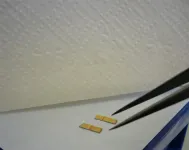A divided cell is a doubled cell
Division and growth of synthetic vesicles
2021-03-25
(Press-News.org) One big challenge for the production of synthetic cells is that they must be able to divide to have offspring. In the journal Angewandte Chemie, a team from Heidelberg has now introduced a reproducible division mechanism for synthetic vesicles. It is based on osmosis and can be controlled by an enzymatic reaction or light.
Organisms cannot simply emerge from inanimate material ("abiogenesis"), cells always come from pre-existing cells. The prospect of synthetic cells newly built from the ground up is shifting this paradigm. However, one obstacle on this path is the question of controlled division--a requirement for having "progeny".
A team from the Max Planck Institute for Medical Research in Heidelberg, Heidelberg University, the Max Planck School Matter to Life, and Exzellenzcluster 3D Matter Made to Order, headed by Kerstin Göpfrich, has now reached a milestone by achieving complete control over the division of vesicles. To achieve this, they produced "gigantic unilamellar vesicles", which are micrometer-sized bubbles with a shell made of a lipid bilayer that resembles a natural membrane. A variety of lipids were combined to produce phase-separated vesicles--vesicles with membrane hemispheres that have different compositions. When the concentration of dissolved substances in the surrounding solution is increased, osmosis causes water to exit the vesicle through the membrane. This shrinks the volume of the vesicle while keeping the membrane surface equal. The resulting tension at the phase interface deforms the vesicles. They constrict themselves along their "equator"--increasingly with increasing osmotic pressure--until the two halves separate completely to form two (now single-phase) "daughter cells" with different membrane compositions. When the separation that occurs depends only on the concentration ratio of osmotically active particles (osmolarity) and is independent of the size of the vesicle.
The method by which the osmolarity is raised also plays no role. The methods used by the team included using a sucrose solution and adding an enzyme that splits glucose and fructose to slowly increase the concentration. Using light to initiate splitting of molecules in the solution gave the researchers complete spatial and temporal control over the separation. Using tightly controlled, local irradiation allowed the concentration to be increased selectively around a single vesicle, triggering it to selectively divide.
The team is also able to grow the single-phase cells back into phase-separated vesicles by fusing them with tiny vesicles that have the other type of membrane. This was made possible by attaching single strands of DNA to both different types of membrane. These bind to each other and bring the membranes of the daughter cell and the mini vesicle into very close contact so that they can fuse. The resulting gigantic vesicles can subsequently undergo further division cycles.
"Although these synthetic division mechanisms differ significantly from those of living cells," says Göpfrich, "the question arises of whether similar mechanisms played a role in the beginnings of life on earth or are involved in the formation of intracellular vesicles."
INFORMATION:
About the Author
Dr. Kerstin Goepfrich leads the research group Biophysical Engineering at the Max Planck Institute for Medical Research and in the Excellence Cluster 3D Matter Made to Order in Heidelberg. The physicist researches the assembly of artificial cells using novel tools such as DNA nanotechnology. As one of the founders of Ring-a-Scientist she is engaged in scientific communication.
https://www.mr.mpg.de/person/53539/14181493
ELSE PRESS RELEASES FROM THIS DATE:
2021-03-25
The team of researchers at Kaunas University of Technology (KTU), Lithuania applied artificial intelligence (AI) methods to evaluate data of human embryo development. The AI-based system photographs the embryos every five minutes, processes the data of their development and notifies any anomalies observed. This increases the likelihood of choosing the most viable and healthy early-stage embryo for IVF procedures. The innovation was developed in collaboration with Esco Medical Technologies, a manufacturer of medical equipment.
Almost one in six couples face infertility; about 48.5 million couples, 186 million individuals worldwide are inflicted. Europe has one of the lowest birth rates in the world, with an average of just 1.55 children per woman.
The most effective form of ...
2021-03-25
By offering a microscopic "tightrope" to cells, Virginia Tech and Johns Hopkins University researchers have brought new insights to the way migrating cells interact in the body. The researchers changed their testing environment for observing cell-cell interaction to more closely mirror the body, resulting in new observations of cells interacting like cars on a highway -- pairing up, speeding up, and passing one another.
Understanding the ways migrating cells react to one another is essential to predicting how cells change and evolve and how they react in applications, such as wound healing and drug delivery. In a study published in the Proceedings of the National Academy of Sciences, a team formed by Mechanical Engineering Associate ...
2021-03-25
Scientists of Tomsk Polytechnic University jointly with colleagues from different countries have developed a new sensor with two layers of nanopores. In the conducted experiments, this sensor showed its efficiency as a sensor for one of the doping substances from chiral molecules. The research findings are published in Biosensors and Bioelectronics (IF: 10,257; Q1) academic journal.
The material is a thick wafer with pores of 20-30 nm in diameter. The scientists grew a layer of metal-organic frameworks (MOF) from Zn ions and organic molecules on these thick wafers. The MOF has about 3 nm nanopores only. It plays the role of a trap for molecules, which must be detected.
"This sensor can operate with chiral molecules. Such substances consisting of chiral molecules are a lot among medical ...
2021-03-25
In the future, photovoltaic cells could be "worn" over clothes, placed on cars or even on beach umbrellas. These are just some of the possible developments from a study published in Nature Communications by researchers at the Physics Department of the Politecnico di Milano, working with colleagues at the University of Erlangen-Nuremberg and Imperial College London.
The research includes among its authors the Institute of Photonics and Nanotechnology (IFN-CNR) researcher Franco V. A. Camargo and Professor Giulio Cerullo. It focused on photovoltaic cells made using flexible organic technology. Today's most popular photovoltaic cells, based on silicone technology, are rigid and ...
2021-03-25
The Miscanthus genus of grasses, commonly used to add movement and texture to gardens, could quickly become the first choice for biofuel production. A new study shows these grasses can be grown in lower agricultural grade conditions - such as marginal land - due to their remarkable resilience and photosynthetic capacity at low temperatures.
Miscanthus is a promising biofuel thanks to its high biomass yield and low input requirements, which means it can adapt to a wide range of climate zones and land types. It is seen as a viable commercial option for farmers but yields ...
2021-03-25
Energy models are used to explore different options for the development of energy systems in virtual "laboratories". Scientists have been using energy models to provide policy advice for years. As a new study shows, energy models influence policymaking around the energy transition. Similarly, policymakers influence the work of modellers. Greater transparency is needed to ensure that political considerations do not set the agenda for future research or determine its findings, the researchers demand.
Renewable energies bring many changes, including fluctuations in the energy supply and a more geographically distributed generation system. ...
2021-03-25
A collaborative research project by team of undergraduate students from the University of Exeter's Natural Sciences department has been published in a prestigious academic journal.
Lewis Howell, Eleanor Osborne and Alice Franklin have had their second-year research published in The Journal of Physical Chemistry B.
Their paper, Pattern Recognition of Chemical Waves: Finding the Activation Energy of the Autocatalytic Step in the Belousov-Zhabotinsky Reaction, was a result of their extended experiment work in the Stage 2 module "Frontiers in Science 2".
Their project involved the Belousov-Zhabotinsky chemical reaction - an ...
2021-03-25
March 7, 2021, KAUST, Saudi Arabia - KAUST Assistant Professor of Computer Science Mohamed Elhoseiny has developed, in collaboration with Stanford University, CA, and École Polytechnique (LIX), France, a large-scale dataset to train AI to reproduce human emotions when presented with artwork.
The resulting paper, "ArtEmis: Affective Language for Visual Art," will be presented at the Conference on Computer Vision and Pattern Recognition (CVPR), the premier annual computer science conference, which will be held June 19-25, 2021.
Described as the "Affective Language for Visual Art," ArtEmis's user interface has seven emotional descriptions on average for each image, bringing the total count to over 439K emotional-explained attributions from humans on ...
2021-03-25
While urban agriculture can play a role in supporting food supply chains for many major American cities -- contributing to food diversity, sustainability and localizing food systems -- it is unrealistic to expect rooftop gardens, community plots and the like to provide the majority of nutrition for the population of a metropolis.
That's the conclusion of a team of researchers who analyzed the nutritional needs of the population of Chicago and calculated how much food could be produced in the city by maximizing urban agriculture, and how much crop land would be needed adjacent to the city to grow the rest. The study was the first to evaluate land required to meet ...
2021-03-25
Scientists have shown that SARS-CoV-2, the virus that causes COVID-19, can infect specific cells in the salivary gland in the mouth. The study by researchers from the Wellcome Sanger Institute, National Institutes of Health and the University of North Carolina at Chapel Hill, and their collaborators within the Human Cell Atlas Oral & Craniofacial Network, also discovered that live cells from the mouth were found in saliva, and that the virus was able to reproduce within these infected cells.
The study revealed that salivary gland cells could play a role in transmission ...
LAST 30 PRESS RELEASES:
[Press-News.org] A divided cell is a doubled cell
Division and growth of synthetic vesicles



